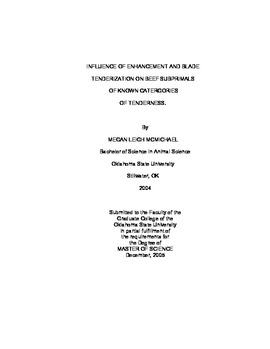| dc.contributor.advisor | Morgan, J. Brad | |
| dc.contributor.author | McMichael, Megan Leigh | |
| dc.date.accessioned | 2014-04-15T18:37:25Z | |
| dc.date.available | 2014-04-15T18:37:25Z | |
| dc.date.issued | 2005-12-01 | |
| dc.identifier.uri | https://hdl.handle.net/11244/8469 | |
| dc.description.abstract | Six paired subprimals (strip loin, knuckle, clod, inside round, eye of round and top sirloin) from US Choice and Select carcasses were enhanced, blade tenderized or aged to increase their tenderness values. Subprimal pairs were randomly assigned to blade tenderization, enhancement or postmortem aging. N=4, steaks were fabricated for postmortem aging of 7 d, 10 d, 14 d, and 21 d . N=2, steaks were fabricated from subprimals and assigned to blade tenderization (two passes) or enhancement and were conventionally aged for 7 d and 14 d. Upon conclusion of each storage period, each steak was frozen (-20�C) until WBSF analysis was conducted. Subprimal pairs with a conventionally aged 7 d steak that exhibited a WBSF ? 4.50 kg were classified as "tough." US Choice and Select enhanced strip loin steaks displayed a lower (P < 0.05) WBSF than blade tenderized or conventionally aged steaks. Enhanced "tough" strip loin, knuckle, and clod steaks possessed lower (P < 0.05) WBSF than blade tenderized or conventionally aged steaks regardless of postmortem aging. Blade tenderized and enhanced "tough" eye of round and top sirloin steaks displayed lower (P < 0.05) WBSF regardless of postmortem aging compared to steaks that were controls. Enhancement of "tender" clod steaks lowered WBSF values (P < 0.05) compared to control and blade tenderized counterparts. Postmortem aging up to 14 d for "tough" strip loin and knuckles steaks proved to be effective (P < 0.05). US Choice and Select "tough" blade tenderized and enhanced clod steaks possessed lower WBSF values (P < 0.05) as well as US Select "tender" enhanced clod steaks. US Choice and Select blade tenderized and enhanced eye of round steaks exhibited lower WBSF values (P < 0.05) than postmortem aging, however, WBSF values would still be considered "tough". It was concluded postmortem aging, enhancement, or blade tenderization or combinations of were significantly effective in increasing overall tenderness in strip loins, knuckles, clods, eye of rounds and top sirloins in the "tough" category. | |
| dc.format | application/pdf | |
| dc.language | en_US | |
| dc.publisher | Oklahoma State University | |
| dc.rights | Copyright is held by the author who has granted the Oklahoma State University Library the non-exclusive right to share this material in its institutional repository. Contact Digital Library Services at lib-dls@okstate.edu or 405-744-9161 for the permission policy on the use, reproduction or distribution of this material. | |
| dc.title | Influence of Enhancement and Blade Tenderization on Beef Subprimals of Known Categories of Tenderness | |
| dc.type | text | |
| dc.contributor.committeeMember | Dewitt, Christina | |
| dc.contributor.committeeMember | Escoubas, Roy | |
| osu.filename | Mcmichael_okstate_0664M_1603.pdf | |
| osu.college | Agricultural Sciences and Natural Resources | |
| osu.accesstype | Open Access | |
| dc.description.department | Department of Animal Science | |
| dc.type.genre | Thesis | |
| dc.subject.keywords | beef | |
| dc.subject.keywords | tenderness | |
| dc.subject.keywords | subprimals | |
| dc.subject.keywords | wbsf | |
